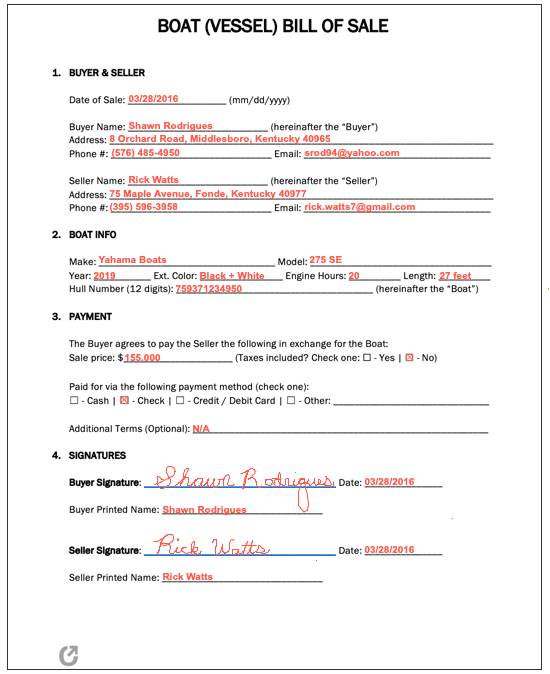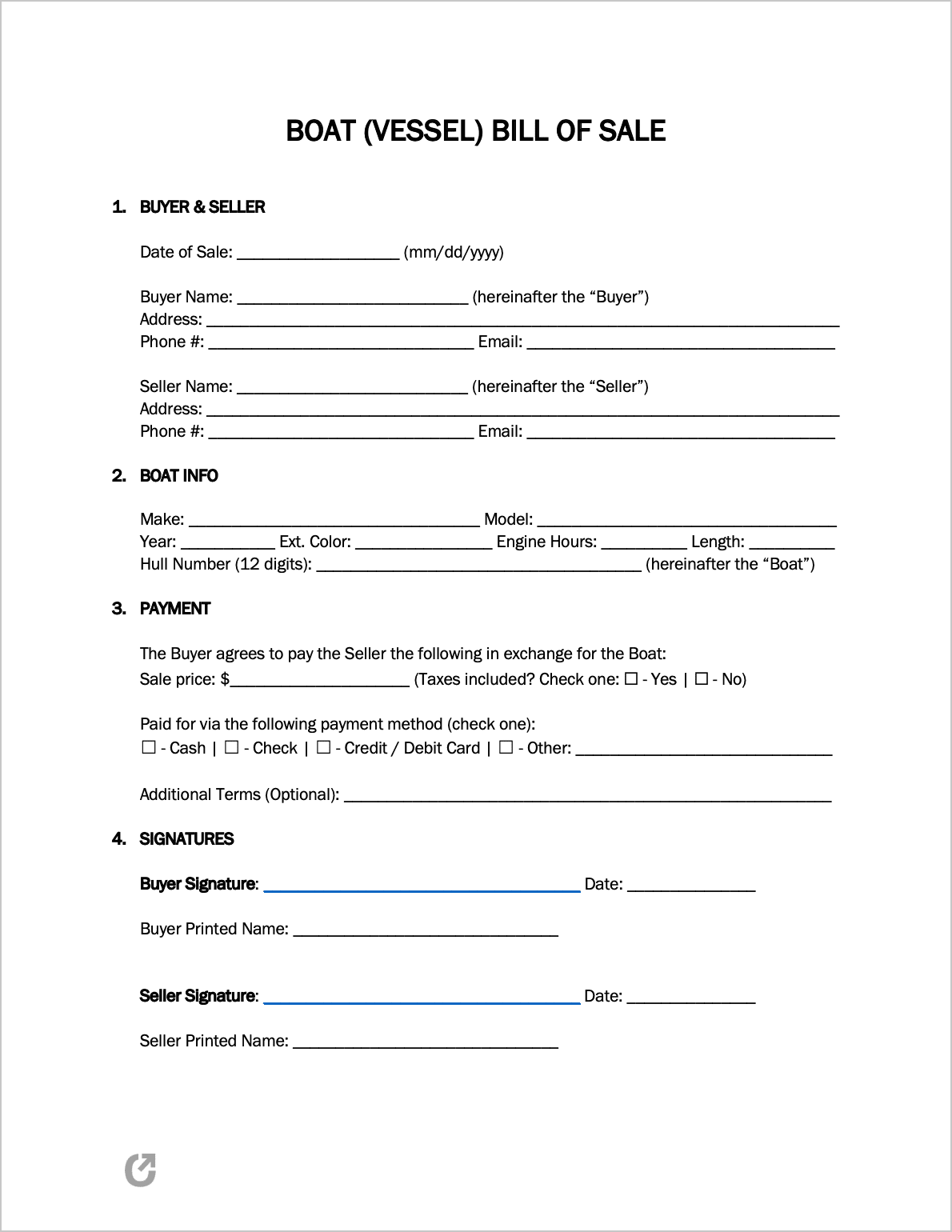Boat Bill of Sale Form
A boat bill of sale is a document that is used to prove a buyer purchased a water vessel from a seller. It contains a description of the boat, the contact information of both parties, and the payment type. Once signed, the document indicates that the seller has released their ownership and transferred it to the buyer. For these reasons, most states require it for registering and titling. Since notarization requirements vary by state, it is recommended to check with local law before signing.
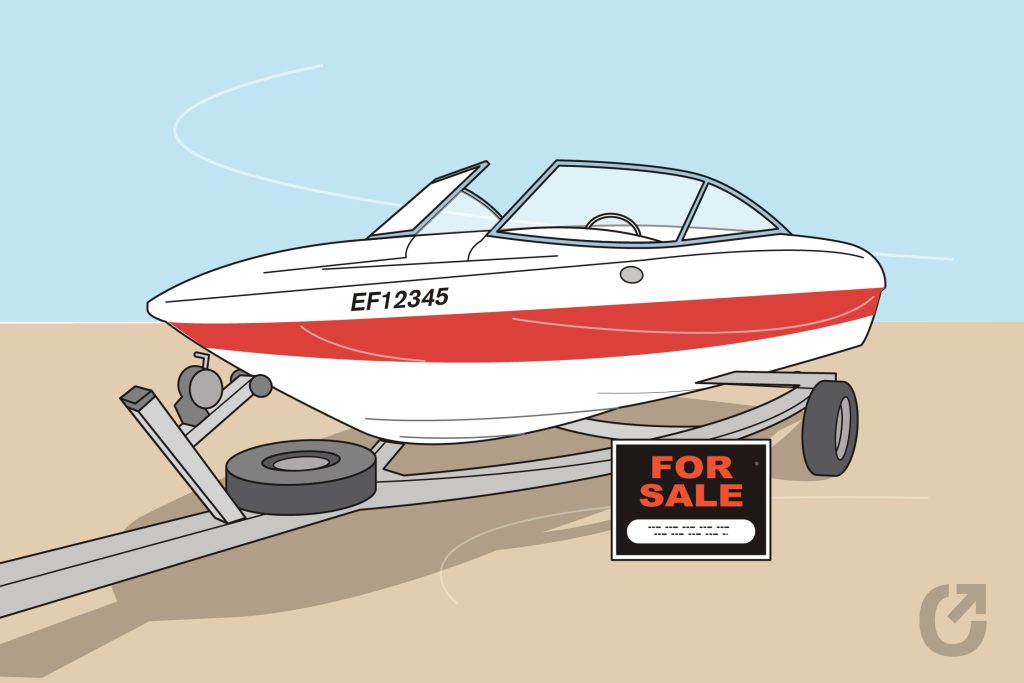
By State
- Alabama
- Alaska
- Arizona
- Arkansas
- California
- Colorado
- Connecticut
- Delaware
- Florida
- Georgia
- Hawaii
- Idaho
- Illinois
- Indiana
- Iowa
- Kansas
- Kentucky
- Louisiana
- Maine
- Maryland
- Massachusetts
- Michigan
- Minnesota
- Mississippi
- Missouri
- Montana
- Nebraska
- Nevada
- New Hampshire
- New Jersey
- New Mexico
- New York
- North Carolina
- North Dakota
- Ohio
- Oklahoma
- Oregon
- Pennsylvania
- Rhode Island
- South Carolina
- South Dakota
- Tennessee
- Texas
- Utah
- Vermont
- Virginia
- Washington
- Washington D.C.
- West Virginia
- Wisconsin
- Wyoming
Contents |
What is a Boat Bill of Sale?
A boat bill of sale is one of the many forms used when selling a boat and must be signed before the title is handed to the buyer. It is essential because it proves that the buyer paid the seller. Similarly, the form protects the seller if the boat has issues following the sale.
The document is used for fishing boats, yachts, sailboats, powerboats, and much more. Include the following information when completing a boat bill of sale:
- Location + Date – The state and town where the transfer took place, as well as the day of the sale.
- Boat – Details of the boat, such as its make, model, year, color, engine hours, length, and hull identification number (HIN). If the owner is selling a trailer, motor, or accessories with the boat, write the specifics of each item.
- Seller – The name, address of residence, cellphone or home number, email, and signature of the person selling the boat.
- Buyer – The full name, street address, phone number, email, and signature of the person buying the boat.
- Payment – An amount that the buyer and seller have agreed upon, as well as additional terms of the sale.
How to Sell a Boat (6 Steps)
Follow the steps below to prepare, advertise, and sell a boat.
- Step One – Prepare it
- Step Two – Collect Paperwork
- Step Three – Take Images
- Step Four – Set a Fair Price
- Step Five – List it
- Step Six – Finalize Bill of Sale
Step One – Prepare it
The first step in the selling process is fixing the boat. It needs to look its best when buyers tour it. When preparing it, remove stains, mold, and rust. Replace small parts and paint over chipped or scratched areas.
After doing minor repairs, clean and wax it. Begin by washing away residue on the outside and focus on the area where the boat sits in the water. On the inside, deep clean rugs, fabrics, and furniture. Sanitize any toilets, showers, kitchens, or other used surfaces.
Step Two – Collect Paperwork
Buyers are more likely to trust sellers who have a record for the boat. These forms prove ownership and show a written history of repair work and accidents.
The title is the most important document when selling a vessel. It shows that the seller is the rightful owner and includes the details needed to identify the boat.
A bill of sale is filled out before the title is given to the new owner. It transfers ownership and acts as a receipt for the sale. The seller needs to have the current bill of sale on hand and complete a new one with the buyer.
If possible, gather order receipts, boat manuals, and other helpful forms to show the buyer when selling.
Step Three – Take Images
The next step is to take pictures with an up-to-date camera. Ensure that the lighting is bright and the background is presentable. Remove clutter from the image so that it looks professional and clean.
After capturing, choose five (5) to ten (10) photos to use in the listing. Select images that are clear and show the boat’s best qualities.
Step Four – Set a Fair Price
The value of a boat is based on its make, model, year, and condition. Owners calculate the selling price using these factors. NADA Guides gives the suggested price, as well as low and average retail costs.
Step Five – List it
Boat owners have multiple options when selling. They can list it themselves, hire a broker, or bring it to a dealer.
Advertising helps to spread the word about the sale. Online sites serve this purpose as they allow interested individuals to look at the vessel remotely. Popular websites include Craigslist, Facebook Marketplace, eBay, and Boat Trader. When creating the ad, set a realistic price, post quality photos, and include an honest description.
Hiring a broker is another option when selling a boat. However, brokers do not accept the job unless the vessel is worth more than $20,000. The owner must pay them a 5-10% commission after the sale, as well.
A dealer takes care of the entire sale as they list the boat, show it, and sell it. Similar to a broker, they take a 10% commission, on average.
Step Six – Finalize Bill of Sale
Once the buyer and seller have agreed on a price, they fill out a boat bill of sale form. It must include the following: the contact information of the buyer and seller, a description of the boat, and the payment details.
If the seller includes additional items in the sale (i.e. trailer, motor, lifejackets, equipment, etc.), write the details of each object in the form.
After the document has been completed, both parties must sign and date it. Each state has specific laws for notarization. Therefore, it is highly recommended to check local requirements before signing.
How to Write
Complete the boat bill of sale using the information below.
- Step One – Personal Information
- Step Two – Boat Details
- Step Three – Payment
- Step Four – Signatures
- Step Five – Notarization
Step One – Personal Information
In the section titled “Buyer & Seller”, write the date of the sale in a day/month/year format. Enter the name, address, phone number (#), and email of the buyer and seller.
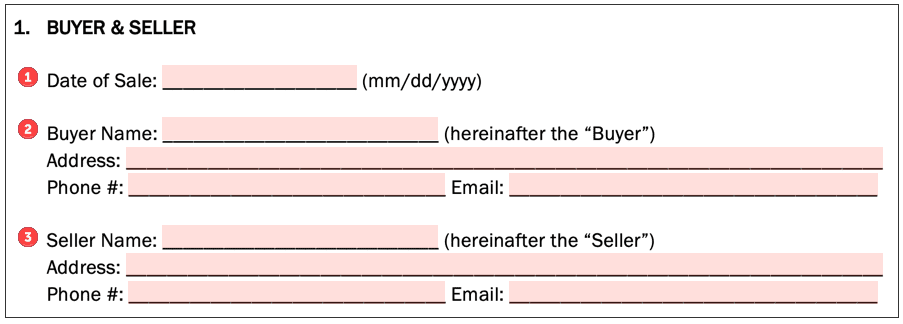
Step Two – Boat Details
Under “Boat Info” fill in the following information about the vessel:
- Make
- Model
- Year
- Exterior Color
- Engine Hours
- Length
- Hull Identification Number (HIN)

Step Three – Payment
Enter the sale price ($). Select the “Yes” box if the buyer paid the taxes for the boat in the transaction and “No” if they did not. In the “Payment Method” section, check off the box labeled “Cash”, “Check”, “Credit / Debit Card”, or “Other” (depending on the type of payment used). List other important payment information on the line titled “Additional Terms.”

Step Four – Signatures
The buyer and seller must include their signature, printed name, and the date of signing under the “Signatures” section.
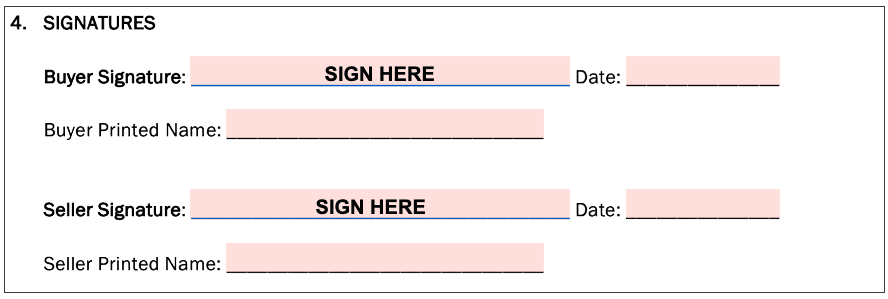
Step Five – Notarization
The bill of sale must be notarized if the state where the seller and buyer live requires it. If it is needed, both parties must sign in front of an official witness (called the “notary public”). As soon as this occurs, the notary public will notarize it using a physical or digital stamp.
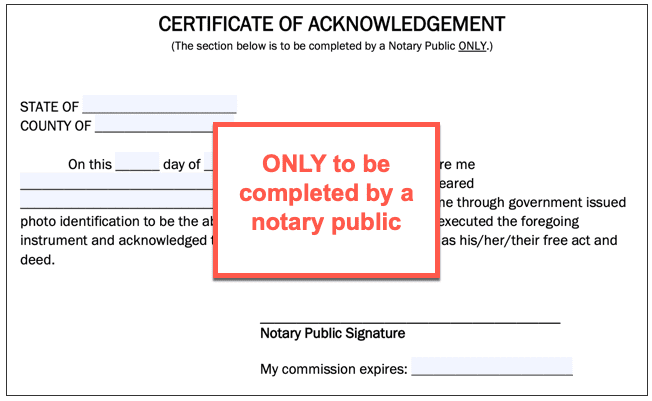
Sample: Boat Bill of Sale
